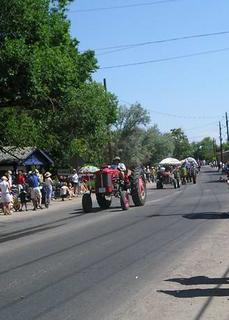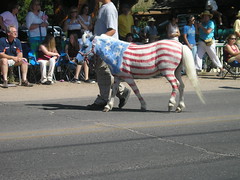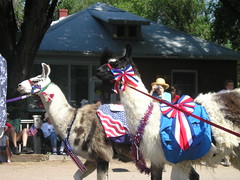It has been many years since we've ventured further west than Acoma, so we packed a picnic and embarked on the drive to Zuni Pueblo. From Acoma onward the vistas stretch out into infinite skies. Passing El Malpais is always interesting, the miles of rough, black lava rock a forbidding and yet beautiful landscape. The conquistadores traversed this vast stretch of dangerous territory in search of the Cibola, the fabled seven cities of gold. It is jagged and sharp, with lava tubes, caves, and sink holes, making it very treacherous terrain. To the north Mount Taylor looms large over the landscape. Mount Taylor's 11,300 foot peak is considered sacred by the Navajo who call it Turquoise Mountain.
Turning south put us into mesa country, with the rock formations rising up along the horizon. The road unrolled itself through the mesas as we approach El Morro National Monument. The sky was completely turquoise and punctuated with bright white, puffy clouds. There is an almost-spiritual feeling in the landscape here. Ancient. Creation. Beautiful.

El Morro National Monument is identifiable from the distance, a huge sandstone rock juts up above the desert floor, beckoning. It beckoned travelers of old with its refreshing natural pool in the shadow of the bluff, and they left their marks on the sandstone, carving their names into the rock. Most begin "Paso por aqui..." I passed this way. Some are elaborate with swirling script. They are a chronicle of the various groups who entered the New Mexico territory...the conquistador and colonizer Don Juan de Onate with the oldest inscription from 1605, Army regiments, passing settlers, they all incised their names on the walls, alongside timeless Anasazi petroglyphs.

Further along the road the striped mesas appear, the striations in the rock colorful against the deep turquoise sky. Graceful rock spires, separate from the larger formations, jut heavenward almost like church steeples and, with the stripes in the rocks reminiscent of several Italian cathedrals we have seen, the impression of a spiritual quality of this landscape deepened. All was silence until a passing truck rumbled by.
The visitors centers for both El Morro and El Malpais were very uncrowded. It is off the beaten path and yet there are miles of trails, a section of the famed Continental Divide Trail passing by here. But it was very hot, in the mid 90s and with nearly full sun exposure, it is still a forbidding landscape, which makes it an unspoiled landscape as well. No developments, no roadside kitsch, nothing to mar the expansive vistas.
We motored into Zuni Pueblo, one of the oldest, the largest, and most traditional of New Mexico's nineteen pueblos, yet unlike many of their tribal neighbors, they are an open pueblo and allow visitors to wander freely. After stopping at the tribal offices to purchase a photo permit, we explored Halona Idiwan'a, the Middle Village, one of the historic residential communities where the Old Zuni Mission and the ceremonial plaza are located. The traditions passed down from time immemorial are still carried on in Zuni. We walked the dusty paths that wind among the stone dwellings; we passed rows of hornos where the oven bread is baked. The Old Mission Church is in serious need of repair, the money the State has allocated will not cover the necessary renovations, we were told.


As we strolled the village, windows would be thrown open with people beckoning, asking if we wanted to buy a kachina or a painting. Zuni is still very much a community of artisans with cottage industry making up the bulk of the residents' livelihoods. The Zuni visitor's guide states that 80% of the pueblo population is involved in artistic endeavors, and they are reknowned for their intricate jewelry designs and their hand-carved fetishes.
We visited a pueblo-owned cooperative which sells jewelry-making supplies to the artists as well as consigns finished products for purchase by visitors. During our stop we witnessed the exchange of several artists with the manager, asking for their wares to be consigned. Some met with success, others received a firm but kindly, "Ummm, I'm going to pass on that one today." The old ways still prevail. I purchased a gorgeous and unusual pair of earrings, as did my sister, hers displaying the famous Zuni inlay of stones. Both items were accompanied by cards of authenticity and the name of the artist. They are, rightfully, very proud of their high quality craftsmanship.

We retraced our route homeward, thoughts lost in the starkness of the picturesque landscape here. These striped mesas and turquoise skies are magnificent, timeless, inspiring. No wonder the Zuni are famed for their works of art; they have daily inspiration.
copyright 2005 Valerie Schneider










